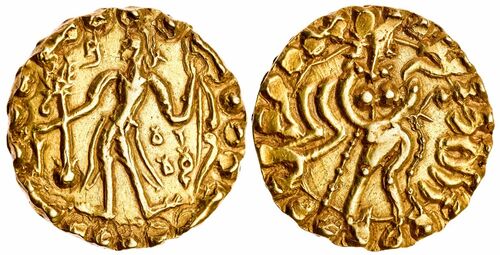
Auction: 23109 - Spink Numismatic e-Circular 29: Indian and Islamic Coins Featuring 'A Gentleman's Collection of Sri Lankan Coins' Part II - e-Auction
Lot: 8177
(x) Ancient India, Post-Gupta Bengal, Samatata region, "Vira Chandrah" (c.635- 640), gold Dinar, 5.69g, kingly figure standing left holding a bow right and an arrow left, a standard topped by a symbol from which flames emerge in left field, Brahmi letter above, Brahmi legend tentatively read as va ra (or vira) chandrah in right field, rev. stylized female figure wearing cloak standing right, pseudo legend in right field (Group E, N. Rhodes (ed. W. Bertsch), "The Coinage of Samatata", JONS 228, Summer 2016, pp.9-15), good extremely fine, rare
After the fall of the Gupta Empire in the 6th century, the history of Bengal is unclear. It is only relatively recently that gold coins of this type have been found in south eastern Bengal, in the area covered by ancient Samatata. Their design is clearly derived from that of the Guptas (or earlier Kushans), with a standing kingly figure on the obverse and a deity or goddess on the reverse. Some of them bear legends in the right field of the obverse that may shed light on the early history of Samatata. In the case of this coin it is thought that "Vira Chandrah" may have been the name of the king, or possibly a ruler of nearby Arakan who bore this name. If the latter, it would provide important evidence of a conquest of Samatata by the Chadra ruler of Arakan during this period.
The references in this listing are taken from a posthumous paper by Nicholas Rhodes, "The Coinage of Samatata" edited by Wolfgang Bertsch, published in the Journal of the Oriental Numismatic Society #228, Summer 2016 https://www.orientalnumismaticsociety.org/archive/ONS_228.pdf#page=15
Subject to 5% tax on Hammer Price in addition to 20% VAT on Buyer’s Premium.
Estimate
£900 to £1,200
Starting price
£800




